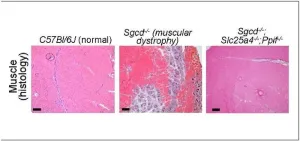(Press-News.org) CHAPEL HILL, NC – Anxiety remains one of the most diagnosed clinical symptoms in adolescence and is a potent precursor to and exacerbator of substance use disorder. In their new $3.8-million study entitled “Neurobiological Pathways from Anxiety Symptomology in Early Adolescence to Risk for Adverse Patterns of Substance Use” funded through the National Institute on Drug Abuse, UNC School of Medicine and Frank Porter Graham Child Development Institute at UNC-Chapel Hill researchers will examine the neural and physiological mechanisms associated with emergence of substance use in adolescence who experience anxiety.
Aysenil Belger, PhD, professor in the UNC Department of Psychiatry and director of the Clinical Translational Core UNC Intellectual and Developmental Disabilities Research Center; and Diana Fishbein, PhD, senior scientist and director of translational neuro-prevention research at the Frank Porter Graham Child Development Institute at UNC-Chapel Hill, are co-principal investigators leading a team of researchers to examine cognitive functions, stress physiology and brain circuits and functions that distinguish adolescents with anxiety who do and do not go on to use psychoactive substances, including alcohol, during adolescence.
Researchers will recruit children ages 12-14 who report symptoms of anxiety. The cohort will then be stratified based on a tool developed by co-PI Ty Ridenhour, PhD, senior research analyst and RTI International; the tool focuses on risk factors such as home life, peer influences, cognitive functioning, impulsivity, risk-taking, and other behaviors to determine if the child has the individual profile that places them at risk of transitioning to substance use. Researchers will compare brain function and stress physiological systems in adolescents who do and do not initiate substance use over five years.
This longitudinal study is testing participants at baseline,12 months and 24 months. Adolescents will be studied using magnetic resonance imaging (MRI) while performing tasks that measure cognitive control, impulsivity, and executive decision-making. Their physiological responses to social stressors, including heart rate, perspiration, and changes in the stress hormone, cortisol, will also be measured. In-depth surveys and toxicology screens are used to determine substance use patterns and a wide range of other child characteristics. The first goal is to first identify the predictors of adverse patterns of substance use in adolescents with anxiety symptoms and, second, to determine what neurobiological mechanisms drive this association. This information will enable the development of more targeted, personalized interventions to prevent pathways of substance use.
“We have very little understanding of the biological differences that explain why some people are prone to substance use or why some children and adolescents get to the point of substance use while others don’t,” Belger said. “Once we find these biological markers, we can identify those at increased risk and what the risk factors are for that individual, and we can develop interventions that enhance cognitive skills or intervene with stress management to keep them off the adverse trajectory, using prevention science.”
Fishbein said, “When young people experience anxiety symptoms, it can compromise the ability of interventions to prevent substance use from developing. In adding to our knowledge about biological processes that underlie anxiety and how they relate to substance use, this study will help us to identify windows of opportunity during child and adolescent development when we can most effectively intervene.”
Although this study focuses on biological “risks” that may propel youth toward substance use, the researchers will also identify protective factors, such as strong connections between cognitive and emotional centers of the brain or supportive social networks that may reduce risk and lead to more positive outcomes for children with anxiety.
Given that a child’s brain is very sensitive to early experiences, identifying conditions that have positive effects should reveal opportunities for strengthening those protective factors to avoid pathways to negative outcomes.
“This research is timely and important,” Belger added. “Post-pandemic anxiety and mental health issues in adolescents are on the rise, and many of the same characteristics we’re studying also contribute to other mental health issues like suicidality. Our study results could identify more than just risk for substance use. There are policy implications as well, including identifying social, structural, and systemic risk factors that contribute to anxiety and substance use.”
Belger, who had directed the Frank Porter Graham Child Development Institute (FPG) for five years, is focused on understanding neurobiological systems, functions and mechanisms that contribute to the development of psychopathology in youth. She works on the biology of high-risk integrating multimodal methodologies such as brain imaging, electrophysiological recordings, and cognitive behavioral assessments.
Fishbein’s career has centered on understanding factors that contribute to the development of psychopathology, focusing on adverse experiences that predict negative outcomes, including substance abuse. She is particularly interested in how evidence-based interventions and policies have the potential to normalize developmental trajectories, leading to positive behavioral and mental health outcomes.
Together, the work of Belger, Fishbein, and Ridenour applies technologies and findings from neuroscience to address outstanding questions in the field of prevention, leading to more effective methods and policy reforms to support the health and well-being of our young people.
The researchers want to bridge with other collaborators studying brain function in adolescents in other circumstances. The team is excited to hear from others who want to add measures to ancillary projects. The researchers are also interested in clinical collaborations for recruitment but also for referral of vulnerable children. To join the collaboration to become a resource for psychoeducation for families, reach out to Aysenil Belger.
UNC Psychiatry contact: Samantha Weiss
END
New mental health partnership looks to explain biological factors behind substance use in adolescents experiencing anxiety
Through a new five-year, $3.8-million NIH-funded project, UNC School of Medicine researchers and colleagues will examine neurological and psychological factors that lead some adolescents with anxiety symptoms to use controlled substances.
2023-08-25
ELSE PRESS RELEASES FROM THIS DATE:
Innovative approach: Detecting malware through hardware-integrated protection
2023-08-25
Imagine a computer that is not slowed down by antivirus software. A computer that does not require constant updates that usually includes a subscription cost. What if malicious software and viruses – or malware – detection could simply be built into the hardware of future computers?
Dr. Marcus Botacin, a visiting assistant professor in the computer science and engineering department at Texas A&M University, recently received a grant from the National Science Foundation (NSF) to develop such a concept.
“This is my first grant application ever,” Botacin said. “This grant includes funding for two Ph.D. students that will be my first graduate students, and ...
Two new projects bring health care to vulnerable groups
2023-08-25
Nansi Boghossian and Melissa Nolan, both associate professors in the Arnold School’s Department of Epidemiology and Biostatistics, have been awarded more than $600K each from The Duke Endowment to lead projects that improve access to health care for underserved populations. Their projects align with the Endowment’s goals to provide essential health care services, particularly for children and families, to residents of the Carolinas.
“To truly achieve health for all, we must develop and test innovative yet practical ...
UC economist finds strong link between park funding, home values
2023-08-25
Ohio residents who vote against tax renewals for parks and recreation spending could be costing themselves a significant amount of wealth in the form of their homes' value, a University of Cincinnati economist found.
David Brasington, PhD, the James C. and Caroline Kautz Chair in Political Economy and professor of economics in UC's Carl H. Lindner College of Business, studied the effect of cutting funding for the maintenance of local parks and recreational areas on housing values for a research article that was published in Journal ...
Is hip replacement safe for people in their 90s? Risks depend on patients' health as well as age
2023-08-25
August 25, 2023 – Potentially modifiable comorbid conditions and complications have a major impact on the risks of total hip arthroplasty (THA) for people in their nineties, reports a study in The Journal of Bone & Joint Surgery. The journal is published in the Lippincott portfolio in partnership with Wolters Kluwer.
Patients ³90 years old have higher complication and mortality rates following THA, as compared with younger patients. But while age is a significant factor, the risks associated with THA in nonagenarians ...
SLU research: Erectile dysfunction linked to undiagnosed prediabetes, type 2 diabetes in young men
2023-08-25
ST. LOUIS — Erectile dysfunction (ED) is more common in older individuals with long-term Type 2 diabetes. However, emerging research at Saint Louis University School of Medicine has found that ED indicates undiagnosed prediabetes and type 2 diabetes in young men under 40.
Although the prevalence of undiagnosed diabetes declined in the United States from 1988 to 2020, 2.5% of the population has persistent undiagnosed diabetes. The Centers for Disease Control and Prevention estimate 8.5 million adults have undiagnosed diabetes, and a quarter of these cases are among young persons 18 to 44.
In a recent study published ...
Children with SEND deserve authentic inclusion in the foreign languages classroom, report warns
2023-08-25
Pupils with special educational needs and disabilities should be given equal opportunities to learn languages, a new report argues.
Anecdotal evidence suggests that children with SEND are often removed from language lessons, because the subject is perceived as “difficult”, an assumption that is further exacerbated by trends with GCSE subject choices. Instead of withdrawing children with additional needs from the foreign languages classroom, opportunities should be provided for them to thrive within it.
Evidence shows learning new languages can be possible and hugely beneficial for many children with ...
New guideline details dental pain management strategies for pediatric patients
2023-08-25
CHICAGO, Aug. 25, 2023 – Acetaminophen or non-steroidal anti-inflammatory drugs (NSAIDs) like ibuprofen are recommended as first-line treatments for managing short-term dental pain in children under age 12, according to a new clinical practice guideline developed by the American Dental Association Science & Research Institute (ADASRI), the University of Pittsburgh School of Dental Medicine and the Center for Integrative Global Oral Health at the University of Pennsylvania School of Dental Medicine. The guideline has been endorsed by the American Dental Association.
A guideline panel determined that, when used as directed, acetaminophen alone, ...
In Type 1 diabetes, verapamil prevents decline of IGF-1 and promotes beta-cell IGF-1 signaling
2023-08-25
BIRMINGHAM, Ala. – In 2012, University of Alabama at Birmingham researcher Anath Shalev, M.D., reported that a decades-old blood pressure medication called verapamil completely reversed diabetes in animal models. In 2018, the team had translated these findings into a randomized, controlled, clinical trial, demonstrating significantly improved beta cell function for one year in human subjects with recent onset Type 1 diabetes. By last year, in a small follow-up study, Shalev and colleagues had found that adult Type 1 diabetes patients taking oral verapamil required less daily insulin ...
How being in space impairs astronauts’ immune system
2023-08-25
A new study led by researchers at Karolinska Institutet in Sweden has examined how T cells of the immune system are affected by weightlessness. The results, which are published in the journal Science Advances, could explain why astronauts’ T cells become less active and less effective at fighting infection.
The next steps in the exploration of space are human missions to the moon and to Mars. Space is an extremely hostile environment that poses threats to human health. One such threat is changes to the immune system that occur in astronauts while in space and ...
Mitochondria pore emerges as potential key to managing muscular dystrophies
2023-08-25
Ever since the Jerry Lewis telethons began in the 1960s, millions of people have become familiar with an otherwise rare disease called muscular dystrophy (MD).
The medical world has learned much over the ensuing years, including that more than 30 closely related disorders exist that can produce the gradual muscle degeneration that steals a child’s ability to walk and eventually disrupts other organ functions. An estimated 250,000 people in the U.S. are living with a muscular dystrophy. While many are living longer lives thanks to improved treatments, no cure has been found.
Now an eye-opening study ...
LAST 30 PRESS RELEASES:
Tracing the quick synthesis of an industrially important catalyst
New software sheds light on cancer’s hidden genetic networks
UT Health San Antonio awarded $3 million in CPRIT grants to bolster cancer research and prevention efforts in South Texas
Third symposium spotlights global challenge of new contaminants in China’s fight against pollution
From straw to soil harmony: International team reveals how biochar supercharges carbon-smart farming
Myeloma: How AI is redrawing the map of cancer care
Manhattan E. Charurat, Ph.D., MHS invested as the Homer and Martha Gudelsky Distinguished Professor in Medicine at the University of Maryland School of Medicine
Insilico Medicine’s Pharma.AI Q4 Winter Launch Recap: Revolutionizing drug discovery with cutting-edge AI innovations, accelerating the path to pharmaceutical superintelligence
Nanoplastics have diet-dependent impacts on digestive system health
Brain neuron death occurs throughout life and increases with age, a natural human protein drug may halt neuron death in Alzheimer’s disease
SPIE and CLP announce the recipients of the 2025 Advanced Photonics Young Innovator Award
Lessons from the Caldor Fire’s Christmas Valley ‘Miracle’
Ant societies rose by trading individual protection for collective power
Research reveals how ancient viral DNA shapes early embryonic development
A molecular gatekeeper that controls protein synthesis
New ‘cloaking device’ concept to shield sensitive tech from magnetic fields
Researchers show impact of mountain building and climate change on alpine biodiversity
Study models the transition from Neanderthals to modern humans in Europe
University of Phoenix College of Doctoral Studies releases white paper on AI-driven skilling to reduce burnout and restore worker autonomy
AIs fail at the game of visual “telephone”
The levers for a sustainable food system
Potential changes in US homelessness by ending federal support for housing first programs
Vulnerability of large language models to prompt injection when providing medical advice
Researchers develop new system for high-energy-density, long-life, multi-electron transfer bromine-based flow batteries
Ending federal support for housing first programs could increase U.S. homelessness by 5% in one year, new JAMA study finds
New research uncovers molecular ‘safety switch’ shielding cancers from immune attack
Bacteria resisting viral infection can still sink carbon to ocean floor
Younger biological age may increase depression risk in older women during COVID-19
Bharat Innovates 2026 National Basecamp Showcases India’s Most Promising Deep-Tech Ventures
Here’s what determines whether your income level rises or falls
[Press-News.org] New mental health partnership looks to explain biological factors behind substance use in adolescents experiencing anxietyThrough a new five-year, $3.8-million NIH-funded project, UNC School of Medicine researchers and colleagues will examine neurological and psychological factors that lead some adolescents with anxiety symptoms to use controlled substances.


